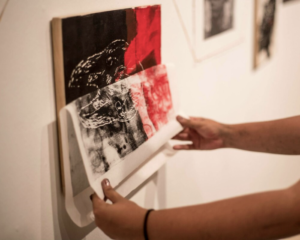Artwork can be an expression of culture, and that’s what the 2022 Indigenous Emerging Artists Program (IEAP) participants are demonstrating in a new exhibit, The Stories We Belong To.
2013 IEAP alumnus Jesse Campbell is a current mentor and coordinator of the program, and he says that part of the purpose of the program is to bridge the gap between contemporary education and the practical workforce. (IEAP was founded in 2013 as a way for Indigenous students to receive guidance, mentorship, and support for their creative and professional endeavours.)
“We want to provide a platform for access. There’s a buzzword going around called ‘networking,’ and yeah, it’s cool, but if the network really isn’t relevant to your needs, or you don’t really know where to begin, that’s not really very helpful, right?” he says. “I spent a lot of time in college coming up with ideas about what I wanted my future to look like, then when I was actually in the workforce, it was a completely different experience. So, when you work with a mentor one on one, you’re actually meeting the person who’s doing the job.”

Campbell says that the idea of Indigenous art is actually fallacious, because in traditional times, art was simply an expression of culture in a practical, functional sense. He says the idea of art in and of itself is a manufactured construct, whereas what we consider to be traditional Indigenous artwork is simply a celebration and expression of culture, which can also be considered beautiful.
“Indigenous art is kind of a misnomer. Traditionally, we didn’t necessarily have art as what we would look at in the Western canon,” Campbell says. “We didn’t have art that was designed to only look beautiful, we had functional pieces of clothing, accessories, and other things which served a purpose. And so, when it comes down to how we differentiate art and culture, they’re one and the same. The different mediums are the articulations of the culture, but the culture itself is inseparable.”
Accordingly, Campbell says that each piece of work is different because each creator is an individual who uses this artwork to share their experience of their culture’s age-old stories in a modern way.
“We need to emphasize that this is the individual person’s relationship to that expression,” says Campbell. “The Stories We Belong To encapsulates the stories we come from as Indigenous people, but also the stories that we celebrate, a part of our traditional lives. Within all these different sort of media, we have different modes of expression for telling these stories in a new way.”
Campbell says that while Canadian culture supports Indigenous artists, it’s focused solely around monetary investment, rather than actively addressing inadequacies in the social system.
“I feel that it all comes down to money,” he says. “Like, I’m not against selling work and receiving payment, I think that’s excellent, but there has to be other ways of supporting folks, of ensuring culturally safe spaces, ensuring that we have an actual dialogue with institutions, and ensuring that we have adequate representation. There has to be a better way of showing support for folks than, ‘Okay, what can I buy from you?’”
Through the IEAP program and this exhibit, Campbell wants to foster awareness of young Indigenous voices and stories. In this way, society as a whole can come together to support the Indigenous community in a more impactful, thoughtful manner.
“I would like people to see value in these young folks, and in these mentorships, and in different forms of expression,” he says, “and in supporting youth outside of the context of ‘What can you do for me?’, instead looking at it as ‘What can we do together, and how can we support each other?’”
The Stories We Belong To
Until Saturday, February 11
Open Space
openspacearts.ca
